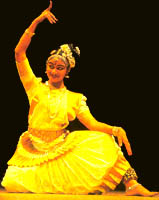Mohiniyattam - Literary Works and Developments
In the 19th century AD, Maharaja Swati Tirunal did much to
encourage and stabilise Mohiniyattam. He made the mu sic aspect of Mohiniyattam
rich and attractive, by composing a number of Varnams, Padams and Tillanas. Swati
Tirunal has to his credit 50 Padams, 20 Varnams and 5 Tillanas. He persuaded
Irayimman Tampi, a notable member of his court who was a gifted poet and
musicologist, to compose musical pieces fit to be used in this dance
pattern. Irayimman Tampi has composed 25 Padams and 5 Varnams. Swati Tirunal
also got Vativelu (one of the Tanjore brothers - Nattuvans) to bring about some
reforms and improvements in the Mohiniyattam dance style and
he took special care to see that these reforms did not in the least, affect the fundamental aspects of this Kerala art
form.
sic aspect of Mohiniyattam
rich and attractive, by composing a number of Varnams, Padams and Tillanas. Swati
Tirunal has to his credit 50 Padams, 20 Varnams and 5 Tillanas. He persuaded
Irayimman Tampi, a notable member of his court who was a gifted poet and
musicologist, to compose musical pieces fit to be used in this dance
pattern. Irayimman Tampi has composed 25 Padams and 5 Varnams. Swati Tirunal
also got Vativelu (one of the Tanjore brothers - Nattuvans) to bring about some
reforms and improvements in the Mohiniyattam dance style and
he took special care to see that these reforms did not in the least, affect the fundamental aspects of this Kerala art
form.
When arranging Navaratri festivals
Swati Tirunal used to include
Mohiniyattam recitals. He had a dance troupe under his patronage. Among the members of this troupe were 3 danseuses from
Kalladikot.
Parameswara
Bhagavatar of Palghat who was at one time attached to the court of Swati Tribunal,
later started a school for Mohiniyattam at Coimbatore. After his rule came to an end,
the standard of
Mohiniyattam declined because of lack of patronage. It was
resurrected in AD 1930, when Mahakavi Vallathol founded Kerala
Kalamandalam. He included Mohiniyattam, along with Kathakali in his plan to
resuscitate ancient Kerala art forms. The first dance teacher of Mohiniyattam in
Kalamandalam was Kalyaniamma. She was an expert in Mohiniyattam and taught
in Kalamandalam for 3 years from 1933. Then she went to Calcutta, at the request
of the great poet, Ravindranath Tagore to teach dancing in his school
Shantiniketan.
Krishna Paniker Asan, the Nattuvan of Mohiniyattam succeeded Kalyaniamma
as teacher in Kalamandalam. After him, the hereditary tradition of the
Nattuvan came an end. The practice of the Nattuvan accompanying the dance with
the cymbals (Kulittalam) on the stage was discontinued when Mohiniyattam came
to be taught in Kerala Kala mandalam. The teaching pattern in Kalamandalam accepted
only the classic features of Mohiniyattam. Items like Esal, Chandanam, Mukkutti
were discarded. Now in Kerala, Mohiniyattam has regained its former standard
(respectfulness). Even maidens from noble families consider training
in Mohiniyattam as a desirable accomplishment. Even foreigners arrive to
undergo training in this art form.


 sic aspect of Mohiniyattam
rich and attractive, by composing a number of Varnams, Padams and Tillanas. Swati
Tirunal has to his credit 50 Padams, 20 Varnams and 5 Tillanas. He persuaded
Irayimman Tampi, a notable member of his court who was a gifted poet and
musicologist, to compose musical pieces fit to be used in this dance
pattern. Irayimman Tampi has composed 25 Padams and 5 Varnams. Swati Tirunal
also got Vativelu (one of the Tanjore brothers - Nattuvans) to bring about some
reforms and improvements in the Mohiniyattam dance style and
he took special care to see that these reforms did not in the least, affect the fundamental aspects of this Kerala art
form.
sic aspect of Mohiniyattam
rich and attractive, by composing a number of Varnams, Padams and Tillanas. Swati
Tirunal has to his credit 50 Padams, 20 Varnams and 5 Tillanas. He persuaded
Irayimman Tampi, a notable member of his court who was a gifted poet and
musicologist, to compose musical pieces fit to be used in this dance
pattern. Irayimman Tampi has composed 25 Padams and 5 Varnams. Swati Tirunal
also got Vativelu (one of the Tanjore brothers - Nattuvans) to bring about some
reforms and improvements in the Mohiniyattam dance style and
he took special care to see that these reforms did not in the least, affect the fundamental aspects of this Kerala art
form.